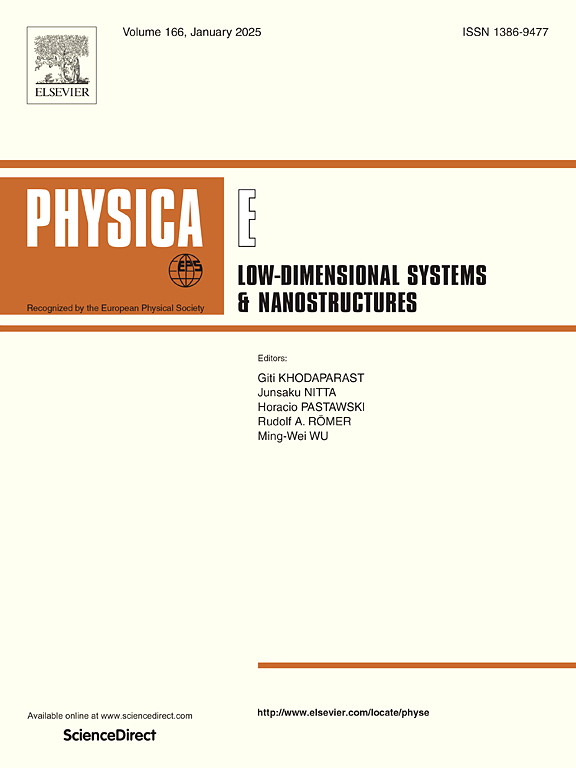Thermal transport across a vacuum gap between two reconstructed Si-nanomembranes
IF 2.9
3区 物理与天体物理
Q3 NANOSCIENCE & NANOTECHNOLOGY
Physica E-low-dimensional Systems & Nanostructures
Pub Date : 2025-03-14
DOI:10.1016/j.physe.2025.116232
引用次数: 0
Abstract
In this work we examine the interaction energy between two reconstructed silicon nanomembranes using a density-functional-based tight-binding (DFTB) approach, focusing on its impact on thermal conductance across a nanogap. By coupling the DFTB method with a harmonic atomistic model, we calculate the vibrational modes (phonons) and the equilibration times, which are directly related to the thermal conductance. Our findings show that surface reconstruction and the relative alignment of facing dimer structures significantly influence the phononic contribution to thermal conductance. Although the harmonic model simplifies the interactions of the real system,our results agree well with previous studies, demonstrating that this model captures key aspects of phonon-mediated heat transfer. Overall, our approach provides a computationally efficient method for understanding phononic heat transfer across nanogaps, with implications for designing nanoscale thermal management systems.
求助全文
约1分钟内获得全文
求助全文
来源期刊
CiteScore
7.30
自引率
6.10%
发文量
356
审稿时长
65 days
期刊介绍:
Physica E: Low-dimensional systems and nanostructures contains papers and invited review articles on the fundamental and applied aspects of physics in low-dimensional electron systems, in semiconductor heterostructures, oxide interfaces, quantum wells and superlattices, quantum wires and dots, novel quantum states of matter such as topological insulators, and Weyl semimetals.
Both theoretical and experimental contributions are invited. Topics suitable for publication in this journal include spin related phenomena, optical and transport properties, many-body effects, integer and fractional quantum Hall effects, quantum spin Hall effect, single electron effects and devices, Majorana fermions, and other novel phenomena.
Keywords:
• topological insulators/superconductors, majorana fermions, Wyel semimetals;
• quantum and neuromorphic computing/quantum information physics and devices based on low dimensional systems;
• layered superconductivity, low dimensional systems with superconducting proximity effect;
• 2D materials such as transition metal dichalcogenides;
• oxide heterostructures including ZnO, SrTiO3 etc;
• carbon nanostructures (graphene, carbon nanotubes, diamond NV center, etc.)
• quantum wells and superlattices;
• quantum Hall effect, quantum spin Hall effect, quantum anomalous Hall effect;
• optical- and phonons-related phenomena;
• magnetic-semiconductor structures;
• charge/spin-, magnon-, skyrmion-, Cooper pair- and majorana fermion- transport and tunneling;
• ultra-fast nonlinear optical phenomena;
• novel devices and applications (such as high performance sensor, solar cell, etc);
• novel growth and fabrication techniques for nanostructures

 求助内容:
求助内容: 应助结果提醒方式:
应助结果提醒方式:


